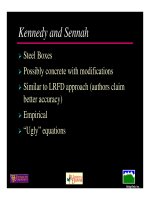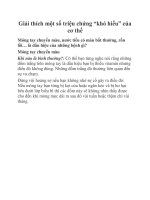Giải thích hệ số PBN - Modeling Appendix
Bạn đang xem bản rút gọn của tài liệu. Xem và tải ngay bản đầy đủ của tài liệu tại đây (501.49 KB, 20 trang )
BridgeTech, Inc.
Modeling Appendix
h
h
1
h
2
l
e1
l
e2
l
i
/2
l
i
/2
l
i
i
l
t
w
t
1
2
t
h
s
t
w
Centroid Axis
of Box-Girder
Exterior
Longitudinal
Girder
Interior
Longitudinal
Girder
h
l
e1
e2
l
i
l
l
e
*
Interior
Longitudinal
Girder
Exterior
Longitudinal
Girder
Closed Section For
Torsional Rigidity
BridgeTech, Inc.
Shear Distribution Factors for CIP Concrete Multicell
Box Beam Bridges -- Validation
Ext Int Exterior Interior Exterior Interior Exterior Interior
1 L 0.620 0.344 0.618 0.338 0.29% 1.84%
2 L 0.644 0.876 0.644 0.889 0.06% 1.45%
3 L 0.654 0.900 0.653 0.915 0.25% 1.69%
1 L 0.618 0.346 0.620 0.336 0.34% 3.03%
2 L 0.637 0.885 0.640 0.891 0.51% 0.68%
3 L 0.645 0.904 0.649 0.913 0.57% 0.93%
1 L 0.643 0.317 0.639 0.310 0.63% 2.08%
2 L 0.669 0.861 0.664 0.815 0.80% 5.36%
3 L 0.679 0.885 0.672 0.877 1.00% 0.95%
1 L 0.635 0.318 0.547 0.289 13.84% 9.10%
2 L 0.667 0.854 0.606 0.759 9.06% 11.18%
3 L 0.679 0.883 0.629 0.817 7.37% 7.50%
1 L 0.722 0.264 0.718 0.257 0.43% 2.52%
2 L 0.774 0.955 0.780 0.948 0.70% 0.65%
3 L 0.779 1.022 0.784 1.033 0.67% 1.02%
1 L 0.706 0.267 0.698 0.261 1.17% 2.26%
2 L 0.767 0.941 0.769 0.930 0.15% 1.18%
3 L 0.776 1.016 0.778 1.022 0.24% 0.63%
1 L 0.652 0.317 0.658 0.314 0.88% 0.95%
2 L 0.675 0.914 0.681 0.936 0.83% 2.40%
1 L 0.642 0.319 0.645 0.335 0.43% 5.12%
2 L 0.671 0.908 0.675 0.983 0.62% 8.30%
SAP2000 BTLiveLoader DifferenceBridge
Type
TTU
Bridge No.
BridgeID No.
Span
Lanes
Loaded
Beam
End
1
2
10141013
2
1
14 1011 1012
2
13
15
Multicell Box Beam
1
2
12 1007 1008
10101009
1
BridgeTech, Inc.
excellent ≥0.9 bad < 0.5
Lever Rule Henry's
Method
LRFD CHBDC STD Sanders Best
Method
1 excellent good good bad bad bad Lever
2 or more excellent acceptable good bad bad bad Lever
1 excellent poor good good good good Lever
2 or more excellent excellent excellent good good good Lever
1 good good good bad bad bad Lever
2 or more good good good poor acceptable bad Lever
1 bad bad bad bad bad bad CHBDC
2 or more acceptable excellent acceptable acceptable acceptable poor Henry's
1 excellent good good poor poor poor Lever
2 or more excellent excellent excellent poor poor poor Lever
1 excellent poor excellent excellent good good Lever
2 or more good excellent good excellent good excellent Henry's
1 excellent excellent good poor poor poor Henry's
2 or more excellent excellent excellent poor poor poor Henry's
1 poor bad excellent acceptable poor poor LRFD
2 or more poor excellent excellent good good good Henry's
1 excellent acceptable excellent poor acceptable bad Lever
2 or more excellent excellent excellent acceptable acceptable poor Lever
1 excellent acceptable excellent acceptable good poor Lever
2 or more good excellent excellent good excellent poor Henry's
1 poor poor poor poor poor poor CHBDC
2 or more good excellent good poor acceptable poor Henry's
1 acceptable bad poor bad poor bad Lever
2 or more poor excellent poor bad poor bad Henry's
1 excellent poor excellent acceptable acceptable poor Lever
2 or more excellent excellent excellent good good acceptable Lever
1 excellent poor acceptable good excellent acceptable STD
2 or more excellent excellent excellent good excellent acceptable Henry's
1 poor bad bad poor bad bad CHBDC
2 or more acceptable good poor poor poor bad Henry's
1 bad excellent bad poor bad bad Henry's
2 or more poor good poor poor poor bad Henry's
Method Rating Based on the Value of the Correlation Coefficient (R
2
) between Each Simplified
Method and Rigorous Analysis
Lanes
Loaded
Girder
Locations
Action
Bridge
Set
Method
0.90 > good ≥0.80 0.80 > acceptable ≥0.70 0.70 > poor ≥0.50
4
3
2
1
Moment
Moment
Shear
Moment
Shear
Moment
Shear
Shear
Exterior
Interior
Exterior
Interior
Exterior
Interior
Exterior
Interior
Exterior
Interior
Exterior
Interior
Exterior
Interior
Exterior
Interior
Slab On I
CIP Tees
Spread
Boxes
Adjacent
Boxes
vvcc
vvcccvc
vvcc
BridgeTech, Inc.
Basics Continued
Deflection is the easiest state
variable to predict
analytically/numerically
Interior girder load effects are
easier to predict than exterior
Loads near midspan distribute
more uniformly than load
applied near supports.
Relative stiffness is primary
and flexure is more important
than is torsion
Most important parameter is
the girder spacing (or
cantilever span)
2
2
3
3
( )
( )
d w
EI M x
dx
d w
EI V x
dx
BridgeTech, Inc.
Prerequisites
We are not proposing to take any one simplified
method “as is”. (unless it really works well).
Analytically-based approaches can be
implemented at different levels (i.e., compute
stiffness parameters) – empirical methods cannot.
Analytically-based approaches can be more easily
extended (in case of limits of application), than
empirically-based methods.
Analytically-based approaches can be as simple as
empirical approaches
BridgeTech, Inc.
Task 1 -- Literature Review
Michael Patritch
Graduate Student
TN Tech
BridgeTech, Inc.
Task 1 -- Literature Critical Findings
Simplified methods
Sanders and Elleby
“Equal Distribution Method” – name is a
misnomer
Canadian Standards
Juxtaposition of stiffness extremes
Stiffness effects
Testing
Analysis and modeling
BridgeTech, Inc.
Sanders and Elleby
NCHRP study
Limitations
Span to 120-ft
Slab on Beam (Orthotropic Plate Theory)
Multi beam (Articulated Orthotropic Plate)
CIP Boxes (Folded Plate)
Considered
Aspect ratio
Relative long/trans flexural stiffness
Relative torsonal stiffness
Field tests for some validation









